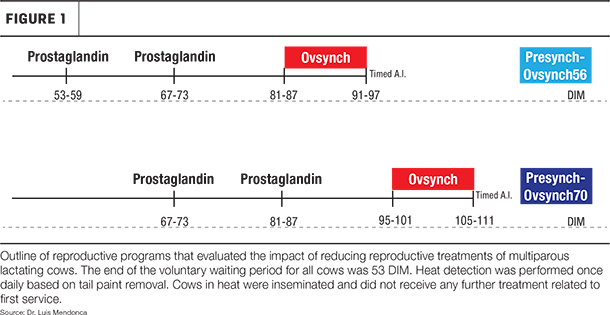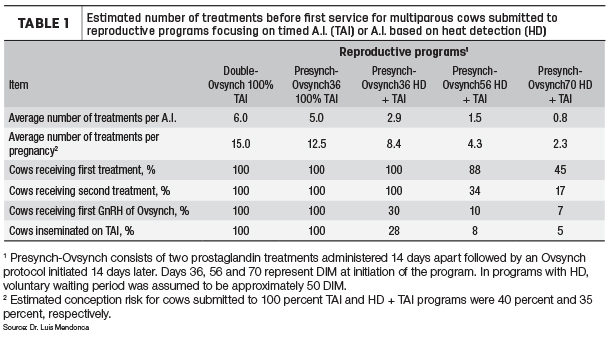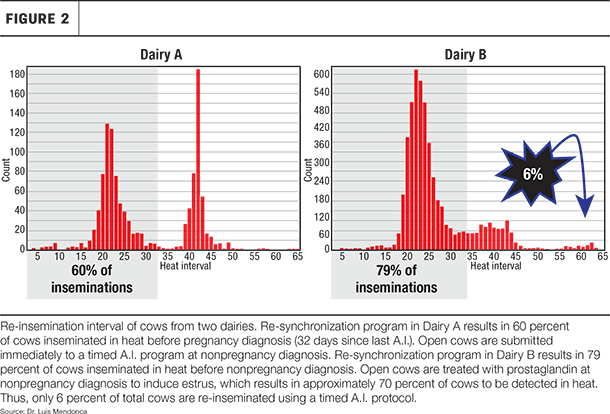At the request of dairy processors, which claim they have a mandate from consumers, rBST has been removed from the toolboxes of many dairy farmers, and some suspect that reproductive hormone therapy could be next.
Dr. Luis Mendonca with the Kansas State University Department of Animal Sciences and Industry shares with Progressive Dairyman his research related to the potential implications that limiting timed-A.I. protocols could have on dairy cow reproductive performance for first-service and subsequent breedings.
Q: Should dairy farmers consider reducing the use of timed-A.I. and synchronization protocols?
MENDONCA: If treatments to synchronize the estrous cycle stand in the spotlight of dairy brand marketers and retailers, the dairy industry will have to justify the reasons why synchronization protocols are used on dairy farms. Although it is easy to list compelling reasons why synchronization programs should be available for reproductive management, it is fundamental that consumers, dairy brand marketers and retailers fully understand why synchronization protocols must be present in the toolbox of producers and veterinarians. It is important to keep in mind that our industry had plenty of explanations why utilizing rBST increased efficiency in dairy farms and it is a safe product; however, for many producers, rBST is currently not part of their toolbox.
The main focus should not be reducing the use of timed-A.I. and synchronization protocols. Instead, the industry should be proactive in educating consumers and food retailers about the subject before synchronization protocols become the next target of an irresponsible marketing strategy.
If synchronization protocols are in the spotlight, questions pertaining to the number of treatments required in synchronization protocols may be inevitable. Thus, we also should start considering if we will be able to justify the number of treatments administered in specific timed-A.I. programs.
The Dairy Cattle Reproduction Council (DCRC) has proactively initiated discussions about the topic. One of the plenary sessions of the last DCRC annual meeting was “Communicating with Consumers about Antibiotic and Hormone Use in Dairy Farms,” presented by Mr. Max Wenck, director of agriculture and pasture-to-plate practices at MorganMyers. The next DCRC annual meeting will be held in Indianapolis on Nov. 14 to 16, 2018, and the topic of communicating practices with consumers will continue to be addressed.
Q: What are the possible benefits versus consequences of minimizing the number of treatments in reproductive programs?
MENDONCA: The potential implications of minimizing the number of treatments in reproductive programs are unknown. In the past decades, researchers have focused on improving synchronization programs, and unfortunately, research projects purposely evaluating the impact of reducing the number of treatments in reproductive programs are lacking in the literature. One can speculate that reducing the number of treatments will impact efficiency of herds because reproductive performance improved tremendously in recent years with the advent of new synchronization programs. Nonetheless, it is likely that improvements in facilities and management practices contributed as much as the use of synchronization programs to increase reproductive efficiency. In addition, the availability of new technologies may reduce the need for utilizing reproductive programs that require several treatments to synchronize the estrous cycle. Thus, it is unknown if and to which extent efficiency will be impacted by minimizing the number of treatments.
In order to evaluate the potential impact of minimizing the number of treatments for first A.I., our research group conducted a field trial on three commercial dairies, and surprisingly, minimal impact in reproductive efficiency was observed by reducing the number of treatments. Findings from the field trial were presented at the High Plains Dairy Conference held in Amarillo, Texas, in March 2018. Briefly, the trial consisted of comparing either initiating a Presynch-Ovsynch program 17 days after the end of the voluntary waiting period (VWP) or immediately after the end of the VWP (Figure 1).

Delaying the start of the synchronization protocol (Presynch-Ovsynch70) increased the number of cows inseminated based on estrus detection before any treatments were administered. No differences were observed in the proportion of cows becoming pregnant and initiating a subsequent lactation between treatments; however, delaying the start of the program slightly increased days open (Presynch-Ovsynch70: 108 median days open; Presynch-Ovsynch56: 102 median days open). These findings suggest that some herds may not be impacted to a great extent if the number of treatments is reduced in reproductive programs. The insemination risk (heat detection rate) of the herds used in the trial was exceptional, which is an important aspect to consider if the goal is to minimize the use of timed-A.I. protocols. Because heat detection efficiency can drive reproductive performance, it is possible herds that have an insemination risk greater than 70 percent may not observe a substantial decrease in reproductive performance if the number of treatments is reduced. Nonetheless, in herds that do not strive to inseminate cows in heat (insemination risk lower than 70 percent), it is extremely likely that reproductive performance will be negatively impacted by minimizing the number of treatments. Because facilities and flooring influence estrus expression, more research needs to be conducted to further understand the outcomes of utilizing programs that do not rely on several treatments. The economic impact of reducing the number of treatments for first A.I. is currently being evaluated.
Ultimately, synchronization programs must be available for dairy herds to maintain efficiency. The “all-or-nothing” approach to treatments in reproductive programs may lead the dairy industry down a delicate path. Therefore, we must have conversations among industry professionals about the topic to anticipate questions from consumers and develop our message to protect the products that are currently available.
Q: Reducing the use of timed-A.I. programs for first service:
• Which programs appear to be most profitable and efficient for first-service breedings?
MENDONCA: Reproductive efficiency can be achieved with both programs (100 percent timed A.I. or most inseminations based on heat detection for first service). Percentage of cows that become pregnant during the entire lactation and days in milk at conception will influence profitability, and there are research studies demonstrating no differences in these indicators when both types of programs were compared. Programs that utilize 100 percent timed A.I. can submit cows to first service in a narrow range of DIM, which can be an advantage, but it may not translate into increased profitability compared with programs that rely mostly on heat detection to inseminate cows. Ultimately, programs that focus on submitting cows to 100 percent timed A.I must strive for outstanding compliance of treatments, and programs that rely on heat detection must have accurate and efficient estrus detection. Independent of the chosen strategy, a large proportion of cows should become pregnant on the first service while not extending DIM at first A.I.
• What would a reduced-treatment program look like for first-service breedings? (Reference your research experiment of Presynch-Ovsynch56 and Presynch-Ovsynch70.)
MENDONCA: A program focusing on reducing treatments for first service should consist of inseminating cows based on heat detection to minimize the proportion of cows submitted to timed A.I. In addition, treatments related to reproductive management should be initiated after the end of the voluntary waiting period. In the field trial that evaluated the impact of reducing the number of treatments, the Presynch-Ovsynch program was utilized and the first PGF was administered either at 56 or 70 DIM (Figure 1). The voluntary waiting period was 53 DIM for all cows. In the Presynch-Ovsynch70, 55 percent of cows were inseminated before the first prostaglandin treatment. By delaying the start of the synchronization program, the number of treatments was reduced by approximately 50 percent. It is important to note that treatments were initiated after the end of the voluntary waiting period for all cows. Therefore, both programs resulted in reduced number of treatments compared with other protocols (Table 1). Outstanding reproductive efficiency must be in place before herds consider strategies to reduce treatments.

Q. Reducing the use of timed A.I. for cows diagnosed “not pregnant”:
• How should resynchronization protocols be focused to reduce the use of timed A.I.?
MENDONCA: Similar to first A.I., resynchronization programs that are aiming to reduce the use of timed A.I. should focus on inseminating cows based on heat detection. Therefore, utilizing treatments with prostaglandin at nonpregnancy diagnosis may be considered to induce estrus. Nonetheless, this strategy can only be used in herds with efficient and accurate heat detection, in which at least 65 percent of cows are inseminated within one week of prostaglandin treatment after nonpregnancy diagnosis. Even though some resynchronization programs result in a large proportion of cows inseminated in heat, timed-A.I. protocols should not be eliminated from resynchronization programs because some cows will not be detected in estrus.
• How can resynch strategies be optimized when using prostaglandin treatments?
MENDONCA: The first and foremost aspect to keep in mind when using prostaglandin treatments is heat detection efficiency and accuracy. Heat detection aids must be utilized to optimize insemination risk, and personnel responsible for the herd reproduction must be trained frequently to assure heat detection efficiency is maximized. Cows not detected in estrus after a prostaglandin treatment should be submitted to an efficient timed-A.I. protocol for an acceptable conception risk. Caution must be taken when choosing the timed-A.I. protocol to acknowledge the compromise of the re-insemination interval and pregnancy outcomes. Nevertheless, only a small proportion of cows are submitted to a timed-A.I. protocol if the herd strives to inseminate cows in estrus. Figure 2 depicts outcomes of two resynchronization programs. The program in Dairy B results in 6 percent of cows inseminated with timed A.I. after utilizing a resynchronization strategy (GGPG protocol one week after prostaglandin treatment). Although the re-insemination interval is extended with this strategy, the protocol results in acceptable conception risk (30 percent) in a subfertile population of cows that do not express estrus. In addition, cows submitted to a timed-A.I. protocol represent a small proportion of the population, which has limited impact in the whole herd reproductive efficiency.

Current herd performance must be evaluated before implementation of resynchronization strategies aiming to inseminate cows in heat after prostaglandin treatments.
Q. What further research needs to be done to accurately estimate the impacts of reducing treatments?
MENDONCA: Research projects focusing on evaluating reproductive efficiency during the entire lactation should be conducted to estimate the real impact of reducing treatments. Because it is imperative for herds to rely on heat detection if treatments are reduced, factors that influence heat detection efficiency should be accounted for, such as type of housing, flooring, stocking density and season. Accounting for these factors in studies will allow researchers to better understand the impact of reducing treatments while considering the diverse array of facilities and management practices across the industry. Finally, the implications on economic outcomes is the main factor to determine if minimizing the use of reproductive treatments is cost-prohibitive. Therefore, economic impact must be addressed in research projects. ![]()

-
Peggy Coffeen
- Editor
- Progressive Dairyman
- Email Peggy Coffeen






